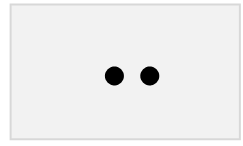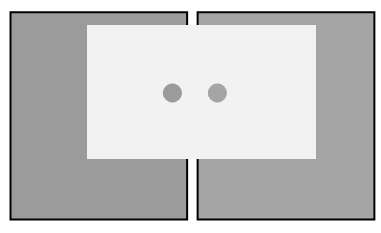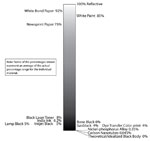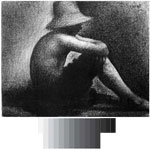VALUE & GAMUT
Value is the relative lightness or darkness of an area.
Gamut is the range of values (or colors) that can be reproduced using a particular medium.
Assignment
The Professor Cosgrovenhoven Manual Comparator
| Punch two holes in a 3 x 5 card… like this: |  |
| Place the comparator over the two values to be compared… isolating small areas of the values makes them easier to evaluate. |  |
Most of you probably noticed that the lightest paint patch in your grayscale is NOT as white as the Bristol board…
the same thing may happen with different media.
- Take a black inkjet rectangle and cut it to the same size as the painted chips of your grayscale. Where does this inkjet black fit against the painted scale… is it darker than the darkest paint? Or is it lighter?
- Do the same with the Laser printed black. Where does it fit in?
- Make a patch of the darkest value you can get with a regular #2 pencil. Where does it fit in?
- Cut out a patch of plain newspaper. Is it lighter or darker than the painted white?
- Find the darkest area of ink in the newspaper… cut out a patch… where does it go.
- Find three or more other media and create patches of the darkest value you can get with each of them.
- Find one white/very light surface and create a patch
- Glue your Grayscale to a larger piece of Bristol and locate the 9 new chips touching one side or the other of the painted grayscale.
- Label it.
-
Neatness counts!




